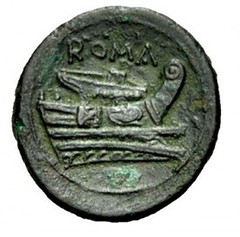
PREV ARTICLE
NEXT ARTICLE
FULL ISSUE
PREV FULL ISSUE
SHIPS ON ANCIENT COINS
On April 20, 2015 Mike Markowitz published the latest article in his CoinWeek Ancient Coin Series. This time, the topic was
"Ships on Ancient Coins." Here's an excerpt and a few images, but be sure to see the complete article online. -Editor
Greeks
Considering the importance of maritime trade and conflict in ancient Greece, it is surprising how few ships appear on archaic (before 500 BCE) and classical (500 – 336 BCE) Greek coins. We hardly ever see a whole ship, usually only the prow (the bow section, with the ram) or the stern (where the steersman sat). Mariners are famously superstitious–was it bad luck to depict an entire ship? Probably not, since vase paintings of this era often show complete vessels. More likely it was simply too difficult for die cutters to engrave so many oars. Even a small warship (the pentekonter) had 25 oars per side, while the standard war vessel (the trireme) had 85 oars per side, packed in three tiers. Phoenicians Beginning in the fifth century BCE, the main coin-issuing Phoenician cities were Tyre (Sur), Sidon (Saida), Byblos (Jubail) and Arados (Arwad). Phoenician coins often represent waves of the sea abstractly as a series of zigzag lines, but ships are shown in considerable detail, with the round shields of warriors arrayed along the railing. A half-shekel of Sidon shows the sail “reefed” up to the yardarm, hanging in loose folds.
Romans Some of the most common and affordable Roman silver coins depicting a ship are the “Legionary” issues struck to pay the army of Mark Antony during the civil war in 32 BCE. These coins honor 23 numbered legions and two elite units, the Praetorian Cohorts (the commander’s bodyguard) and the Speculatores (who served as scouts).
To read the complete article, see:
Wayne Homren, Editor The Numismatic Bibliomania Society is a non-profit organization promoting numismatic literature. See our web site at coinbooks.org. To submit items for publication in The E-Sylum, write to the Editor at this address: whomren@gmail.com To subscribe go to: https://my.binhost.com/lists/listinfo/esylum All Rights Reserved. NBS Home Page Contact the NBS webmaster 
|


